Current Trends of Durability Design and Government Support in South Korea: Chloride Attack
Abstract
:1. Introduction
- (1)
- The determination of the intended service life of the infrastructure: Concrete is considered an economical and durable construction material. In small structures, durability problems can be controlled by simple measures such as sufficient concrete cover depth and a low water/cement (w/c) ratio. However, structures are constructed on a large scale with various types; therefore, the significance of the life cycle costs (LCC) for maintenance increases accordingly [7,8]. In order to secure cost benefits and the required performance at the same time, an intended service life should be determined in the planning stage. Several important structures are planned to maintain performance for 100 years or longer without active repairing or retrofitting [1,9]. LCC analysis for infrastructure covers the costs from initial construction to the dismantling process, and plays an important role in cost savings and optimization of maintenance processes [7,8]. The determination of intended service life, considering the significance of the structure, the maintenance costs, and the difficulties of repairing, is the first step of durability design.
- (2)
- Increasing users’ needs for maintenance: Before 1990, the serviceability of a structure was simply achieved through satisfying the requirements regarding structural safety. However, the user needs as well as maintenance expenses are increasing owing to an expectation of more safe and convenient usage of the structures. Corrosion control and the related repairs in the USA are reported to require $3.6 trillion [6,10]. User needs can be another expense since citizens are users and reporters of corrosion detection at the same time [11]. The increasing repair costs in South Korea are shown in Figure 1 for different structure types [12].
- (3)
- Long service life for sustainability: With the extension of service life of RC structures without large-scale repairs, concrete usage can be reduced. During clinker manufacturing, 0.9 tons of CO2 emissions are reported per 1.0 ton of cement [13]. The maintenance-free period is currently recognized as a critical period since other construction efforts, and repairs on a large-scale cause additional environmental impacts. Previous research on life cycle CO2 (LCCO2), i.e., the evaluation of total CO2 emissions, reported that an initial investment into construction materials and design details for reducing CO2 was the most sustainable solution when compared with the total CO2 considering frequent repairs and small CO2 uptake in use [14].
- (4)
- Reduction in social impact: Social impact is defined as “the consequences to human populations of any public or private actions that alter the ways in which people live, work, play, relate to one another, organize to meet their needs, and generally cope as members of society” [15] (p. 1436). Several reports have shown that construction projects affect human population, communities, and social relationships [15,16]. For example, human health and a reasonable quality of life cannot be achieved when living near a construction site owing to noise issues and traffic obstructions. The extension of the service life of a structure can contribute to the members of a community feeling settled.
2. Deterministic and Probabilistic Durability Design for Chloride Attack
2.1. Overview of Durability Design in Specifications and Design Codes
2.2. Durability Design Based on the Deterministic Method
2.3. Durability Design Based on the Probabilistic Method
2.4. Engineering Limitations of the Two Methods
3. Current Durability Design Methodology
3.1. Durability Design of Concrete Specifications and Structural Design Codes
3.2. Foreign Trends in Durability Design
3.2.1. Japan
3.2.2. United States of America (USA)
3.2.3. European Union (EU)
3.3. South Korea
3.3.1. Concrete Specifications
3.3.2. South Korea’s Governmental Support for Durability and Sustainability
4. Conclusions
Acknowledgments
Conflicts of Interest
References
- Comité Euro-International du Béton (CEB) Task-Group 5.1, 5.2. New Approach to Durability Design; Bulletin 238; Comité Euro-International du Béton (CEB): Stuttgart, Germany, 1997. [Google Scholar]
- Precast/Prestressed Concrete Institute (PCI). Bridge Design Manual; Precast/Prestressed Concrete Institute (PCI): Chicago, IL, USA, 2003. [Google Scholar]
- Broomfield, J.P. Corrosion of Steel in Concrete: Understanding, Investigation and Repair; CRC Press: London, UK, 2006. [Google Scholar]
- RILEM. Durability Design of Concrete Structures; Report of RILEM Technical Committee 130-CSL; E&FN: London, UK, 1994. [Google Scholar]
- Roberts, C. Minneapolis Bridge Collapse. Available online: http://www.croberts.com/minneapolis-bridge-collapse.htm (accessed on 5 August 2016).
- National Association of Corrosion Engineers (NACE) International. Corrosion Costs and Preventive Strategies in the United; No. FHWA-RD-01-156; National Association of Corrosion Engineers (NACE) International: Houston, TX, USA, 2002; Available online: http://impact.nace.org/documents/ccsupp.pdf (accessed on 7 August 2016).
- Asiedu, Y.; Gu, P. Product lifecycle cost analysis: State of the art review. Int. J. Product. Res. 1998, 36, 883–908. [Google Scholar] [CrossRef]
- Kim, S.K.; Lee, S.H.; Na, Y.J.; Kim, J.T. Conceptual model for LCC-based LCCO2 analysis of apartment buildings. Energy Build. 2013, 64, 285–291. [Google Scholar] [CrossRef]
- American Concrete Institute (ACI) Committee-201. Guide to Durable Concrete, Manual of Concrete Practice Part 1; American Concrete Institute (ACI): Detroit, MI, USA, 1994. [Google Scholar]
- Lee, H.S. Proposal for Innovative Durable Building and Infrastructure Research Center; Hanyang Press: Ansan, Korea, 2015. (In Korean) [Google Scholar]
- Kim, H.S.; Kim, J.C.; Yoo, H.J. The cause for a deterioration of concrete structures by deicing salts. In Proceedings of the KCI Conference, Yeosu City, Korea, 14–15 May 2013; Lee, H.S., Ed.; Korea Concrete Institution: Seoul, Korea, 2013; Volume 1, pp. 137–138. [Google Scholar]
- Korea Development Institute. A Study on Estimation of Pavement Maintenance for Preliminary Feasibility Plan—Technical Report of Policy Research; Kibodang Press: Seoul, Korea, 2009. [Google Scholar]
- International Organization for Standardization (ISO). Environmental Management-Lifecycle Assessment-Principles and Framework, ISO-14040; International Organization for Standardization (ISO): Geneva, Switzerland, 2006. [Google Scholar]
- Kim, S.J.; Mun, J.M.; Lee, H.S.; Kwon, S.J. CO2 emission and storage evaluation of RC underground structure under carbonation considering service life and mix conditions with fly ash. J. Content 2014, 14, 1000–1009. [Google Scholar]
- Wang, Y.; Han, Q.; Vries, B.; Zuo, J. How to the public reacts to social impacts in construction project? A structural equation modeling study. Int. J. Proj. Manag. 2016, 34, 1433–1448. [Google Scholar] [CrossRef]
- Juslén, J. Social impact assessment: A look at Finnish experiences. Proj. Apprais. 1995, 10, 163–170. [Google Scholar] [CrossRef]
- Japan Society of Civil Engineering (JSCE). Concrete Library 109: Proposal of the Format for Durability Database of Concrete; Japan Society of Civil Engineering (JSCE): Tokyo, Japan, 2002. [Google Scholar]
- Comité Euro-International du Béton (CEB). CEB-FIP, Model Code 90; Bulletin 213/214; Comité Euro-International du Béton (CEB): Stuttgart, Germany, 1993. [Google Scholar]
- Nagataki, S.; Tsuji, Y.; Sugiyama, T. Proposed Specification of Durability Design for Concrete Structures, Concrete Library of JSCE; No. 27; Japan Society of Civil Engineering (JSCE): Tokyo, Japan, 1996; pp. 35–61. [Google Scholar]
- Tomosawa, H. Study on Durability Design and Construction Standard of Reinforced Concrete Construction; Technical Report; University of Tokyo: Tokyo, Japan, 1997. [Google Scholar]
- Thomas, M.D.A.; Bentz, E.C. Computer Program for Predicting the Service Life and Life-Cycle Costs of Reinforced Concrete Exposed to Chlorides, Life365 Manual; Silica Fume Association (SFA): Lovettsville, VA, USA, 2002. [Google Scholar]
- Tang, L.; Joost, G. On the mathematics of time-dependent apparent chloride diffusion coefficient in concrete. Cem. Concr. Res. 2007, 37, 589–595. [Google Scholar]
- Poulsen, E. On a Model of Chloride Ingress into Concrete, Nordic Miniseminar—Chloride Transport; Department of Building Materials, Chalmers University of Technology: Gothenburg, Sweden, 1993. [Google Scholar]
- Yuan, Q.; Shi, C.; Schutter, G.D.; Audenaert, K. Effect of temperature on transport of chloride ions in concrete. In Concrete Repair, Rehabilitation and Retrofitting II; Alexander, M.G., Beushausen, H.-D., Dehn, F., Moyo, P., Eds.; CRC Press: Leiden, The Netherlands, 2009; Volume 9, pp. 159–160. [Google Scholar]
- Saetta, A.V.; Scotta, R.V.; Vitaliani, R.V. Analysis of Chloride Diffusion into Partially Saturated Concrete. ACI Mater. J. 1993, 90, 441–451. [Google Scholar]
- Kwon, S.J.; Na, U.J.; Park, S.S.; Jung, S.H. Service life prediction of concrete wharves with early-aged crack: Probabilistic approach for chloride diffusion. Struct. Saf. 2009, 31, 75–83. [Google Scholar] [CrossRef]
- Thomas, M.D.A.; Bamforth, P.B. Modeling chloride diffusion in concrete: Effect of fly ash and slag. Cem. Concr. Res. 1999, 29, 487–495. [Google Scholar] [CrossRef]
- Lee, S.H.; Kwon, S.J. Experimental study on the relationship between time-dependent chloride diffusion coefficient and compressive strength. J. Korea Concr. Inst. 2012, 24, 715–726. [Google Scholar] [CrossRef]
- Andrade, C.; Diez, J.M.; Alonso, C. Mathematical modeling of a concrete surface “Skin Effect” on diffusion in chloride contaminated media. Adv. Cem. Based Mater. 1997, 6, 39–44. [Google Scholar] [CrossRef]
- Seo, J.S.; Kwon, S.J. Analysis for chloride penetration in concrete under deicing agent using multi-layer diffusion. J. Contents 2016, 16, 114–122. [Google Scholar] [CrossRef]
- Nordtest. Concrete Hardened: Accelerated Chloride Penetration; NT Build-443; Nordtest: Espoo, Finland, 1995; Available online: http://www.nordtest.info/index.php/methods/building/item/concrete-hardened-accelerated-chloride-penetration-nt-build-443.html (accessed on 8 August 2016).
- Hussain, S.E.; Rasheeduzafar, S.; Al-Musallam, A.; Al-Gahtani, A.S. Factors affecting threshold chloride for reinforcement corrosion in concrete. Cem. Concr. Res. 1995, 25, 1543–1555. [Google Scholar] [CrossRef]
- Alonso, C.; Castellote, M.; Andrade, C. Chloride threshold dependence of pitting potential of reinforcements. Electrochem. Acta 2002, 47, 3469–3481. [Google Scholar] [CrossRef]
- Bamforth, P.B. The derivation of input data for modelling chloride ingress from eight-years UK coastal exposure trials. Mag. Concr. Res. 1999, 51, 87–96. [Google Scholar] [CrossRef]
- Thomas, M. Chloride thresholds in marine concrete. Cem. Concr. Res. 1996, 26, 513–519. [Google Scholar] [CrossRef]
- Pettersson, K. Chloride threshold value and corrosion rate in reinforcement concrete. In Concrete 2000; Dhir, R.K., Jones, M.R., Eds.; E&FN: London, UK, 1993; Volume 1, pp. 461–471. [Google Scholar]
- Tuutti, K. Effect of cement type and different additions on service life. In Concrete 2000; Dhir, R.K., Jones, M.R., Eds.; E&FN: London, UK, 1993; Volume 1, pp. 1285–1296. [Google Scholar]
- Hansson, C.M.; Sorensen, B. The threshold concentration of chloride in concrete for initiation of reinforcement corrosion. In Corrosion Rates of Steel in Concrete; ASTM STP 1065; Berke, N.S., Chaker, V., Whiting, D., Eds.; ASTM International: Philadelphia, PA, USA, 1990; pp. 3–16. [Google Scholar]
- Vassie, P. Reinforcement corrosion and the durability of concrete bridges. Proc. Inst. Civ. Eng. 1984, 76, 713–723. [Google Scholar] [CrossRef]
- Tang, L.; Nilsson, L.O. Chloride binding capacity and binding isotherms of OPC and mortar. Cem. Concr. Res. 1993, 23, 347–353. [Google Scholar]
- Tuutti, K. Corrosion of Steel in Concrete; CBI Report No. 4-82; Swedish Cement and Concrete Research Institute (CBI): Stockholm, Sweden, 1982. [Google Scholar]
- Ary, C.; Buenfeld, N.R.; Newmann, J.B. Factors Influencing Chloride Binding in Concrete. Cem. Concr. Res. 1990, 20, 291–300. [Google Scholar] [CrossRef]
- Park, S.S.; Kwon, S.J.; Jung, S.H. Analysis technique for chloride penetration in cracked concrete using equivalent diffusion and permeation. Constr. Build. Mater. 2012, 29, 183–192. [Google Scholar] [CrossRef]
- Maekawa, K.; Ishida, T.; Kishi, T. Multi-Scale Modeling of Concrete Performance. J. Adv. Concr. Technol. 2003, 1, 91–126. [Google Scholar] [CrossRef]
- Ishida, T.; Maekawa, K. Modeling of durability performance of cementitious materials and structures based on thermohygro physics. In RILEM Proc-PRO29, Proceedings of the 2nd International RILEM Workshop on Life Prediction and Aging Management of Concrete Structures, Paris, France, 13–14 May 2003; Naus, D.J., Ed.; RILEM Publications: Paris, France, 2003; Volume 1, pp. 39–49. [Google Scholar]
- Ishida, T.; Chaube, R.P.; Maekawa, K. Modeling of pore content in concrete under generic drying wetting conditions. Concr. Libr. JSCE 1996, 18, 113–118. [Google Scholar] [CrossRef]
- Park, S.S.; Kwon, S.J.; Jung, S.H.; Lee, S.W. Modeling of water permeability in early aged concrete with cracks based on micro pore structure. Constr. Build. Mater. 2012, 27, 597–604. [Google Scholar] [CrossRef]
- Maekawa, K.; Ishida, T.; Kishi, T. Multi-Scale Modeling of Structural Concrete; Taylor & Francis: London, UK, 2009. [Google Scholar]
- Na, U.J.; Kwon, S.J. Probability-based durability design for concrete structure with crack: Bimodal distribution of chloride diffusion. J. Recycle Constr. Resour. 2015, 3, 22–33. [Google Scholar] [CrossRef]
- Lounis, Z. Probabilistic modeling of chloride contamination and corrosion of concrete bridge structures. In Proceedings of the 4th International Symposium on Uncertainty Modelling and Analysis (ISUMA), College Park, MD, USA, 21–24 September 2003; Institute of Electrical and Electronics Engineers (IEEE): New York, NY, USA, 2003. [Google Scholar]
- Bentz, E.C. Probabilistic Modeling of Service life for Structures Subjected to Chlorides. ACI Mater. J. 2003, 100, 391–397. [Google Scholar]
- Gulikers, J. Considerations on the reliability of service life predictions using a probabilistic approach. J. Phys. IV Fr. 2006, 136, 233–241. [Google Scholar] [CrossRef]
- Pack, S.W.; Jung, M.S.; Song, H.W.; Kim, S.H.; Ann, K.Y. Prediction of time dependent chloride transport in concrete structures exposed to a marine environment. Cem. Concr. Res. 2010, 40, 302–312. [Google Scholar] [CrossRef]
- Kong, J.S.; Ababneh, A.N.; Frangopol, D.M.; Xi, Y. Reliability analysis of chloride penetration in saturated concrete. J. Prob. Eng. Mech. 2002, 7, 305–315. [Google Scholar] [CrossRef]
- DuraCrete, Final Technical Report-Probabilistic Performance Based Durability Design of Concrete Structures; Document BE95-1347/R17; European Brite-Euram Programme: Gouda, The Netherlands, 2000.
- Edvardsen, C.K.; Kim, Y.J.; Park, S.J.; Jeong, S.K.; Im, H.C. Busan-Geoje fixed link concrete durability design for the bridges and tunnels. Tunn. Undergr. Space Technol. 2006, 21, 432–437. [Google Scholar] [CrossRef]
- Na, U.J.; Kwon, S.J.; Chaudhuri, S.R.; Shinozuka, M. Stochastic model for service life prediction of RC structures exposed to carbonation using random field simulation. KSCE J. Civ. Eng. 2012, 16, 133–143. [Google Scholar] [CrossRef]
- Stewart, M.G.; Mullard, J.A. Spatial time-dependent reliability analysis of corrosion damage and the timing of first repair for RC structures. Eng. Struct. 2007, 29, 1457–1464. [Google Scholar] [CrossRef]
- Stewart, M.G.; Rosowsky, D.V. Time-dependent reliability of deteriorating reinforced concrete bridge decks. Struct. Saf. 2004, 20, 91–109. [Google Scholar] [CrossRef]
- Sudret, B.; Defaux, G.; Pendola, M. Time-variant finite element reliability analysis—Application to the durability of cooling towers. Struct. Saf. 2005, 27, 93–112. [Google Scholar] [CrossRef]
- Gjorv, O.E. Steel corrosion in concrete structures exposed to Norwegian marine environment. Concr. Int. 1994, 16, 35–39. [Google Scholar]
- European Committee for Standardization (Comité Européen de Normalisation, CEN). Eurocode 1: Basis of Design and Actions on Structures; EN-1991; European Committee for Standardization (Comité Européen de Normalisation, CEN): Brussels, Belgium, 2000. [Google Scholar]
- Korea Concrete Institute. Concrete Standard Specification-Durability Part, South Korea; KCI Press: Seoul, Korea, 2012. [Google Scholar]
- Japan Society of Civil Engineering (JSCE). Standard Specification for Concrete Structures—Design; JSCE-Guidelines for Concrete 15; Japan Society of Civil Engineering (JSCE): Tokyo, Japan, 2007; Available online: http://www.jsce-int.org/system/files/JGC15_Standard_Specifications_Design_1.0.pdf (accessed on 2 December 2016).
- Japan Society of Civil Engineering (JSCE). Test Method for Effective Diffusion Coefficient of Chloride Ion in Concrete by Migration; JSCE Standards-571; Japan Society of Civil Engineering (JSCE): Tokyo, Japan, 2003. [Google Scholar]
- Japan Society of Civil Engineering (JSCE). Test Method for Apparent Diffusion Coefficient of Chloride Ion in Concrete by Immersion in Salt Water; JSCE Standards-572; Japan Society of Civil Engineering (JSCE): Tokyo, Japan, 2003. [Google Scholar]
- Japan Society of Civil Engineering (JSCE). Standard Specification for Concrete Structures—Materials and Construction; JSCE-Guidelines for Concrete 16; Japan Society of Civil Engineering (JSCE): Tokyo, Japan, 2007; Available online: http://www.jsce-int.org/system/files/JGC16_Standard_Specifications_Materials_and_Construction_1.1.pdf (accessed on 6 December 2016).
- American Concrete Institute (ACI). Building Code Requirements for Structural Concrete and Commentary; ACI 318-11; American Concrete Institute (ACI): Detroit, MI, USA, 2011. [Google Scholar]
- American Concrete Institute (ACI) Committee-201. Guide to Durable Concrete; ACI 201R-08; American Concrete Institute (ACI): Detroit, MI, USA, 2008. [Google Scholar]
- American Concrete Institute (ACI) Committee-210. Erosion of Concrete in Hydraulic Structures; ACI 210R-93; American Concrete Institute (ACI): Detroit, MI, USA, 1998. [Google Scholar]
- American Concrete Institute (ACI) Committee-362. Guide for the Design of Durable Parking Structures; ACI 362.1R-97; American Concrete Institute (ACI): Detroit, MI, USA, 2002. [Google Scholar]
- American Concrete Institute (ACI) Committee-357. State-of-the-Art-Report on Offshore Concrete Structures for the Arctic; American Concrete Institute (ACI): Detroit, MI, USA, 1991. [Google Scholar]
- European Committee for Standardization (Comité Européen de Normalisation, CEN). Eurocode 2: Design of Concrete Structure; EN-1992-1-1; European Committee for Standardization (Comité Européen de Normalisation, CEN): Brussels, Belgium, 2004. [Google Scholar]
- British Standards Institution (BSI). Maritime Structures: Code of Practice for General Criteria; British-Standard 6349-1; British Standards Institution (BSI) Group: London, UK, 2000. [Google Scholar]
- Korea Ministry of Land, Infrastructure and Transport (KMLIT). Concrete Structure Design Code; 11-1611000-002422-14; Korea Ministry of Land, Infrastructure and Transport (KMLIT): Seoul, Korea, 2012.
- Korea Ministry of Land, Infrastructure and Transport (KMLIT). Bridge Structure Design Code; 11-1611000-002699-14; Korea Ministry of Land, Infrastructure and Transport (KMLIT): Seoul, Korea, 2013.
- Korea Ministry of Land, Infrastructure and Transport (KMLIT). Harbor Structure Specification; 11-1611000-002639-14; Korea Ministry of Land, Infrastructure and Transport (KMLIT): Seoul, Korea, 2012.
- Korea Society of Civil Engineering. Civil Engineer’s Proposal for Safe Society-Preparation Strategy for the Aging SOC. In Proceedings of the 2nd Forum on Future Policies, Ilsan, Korea, 17 April 2015; Shin, C.-G., Kim, K.J., Eds.; KSCE Press: Seoul, Korea, 2015; Volume 4, pp. 26–40. [Google Scholar]
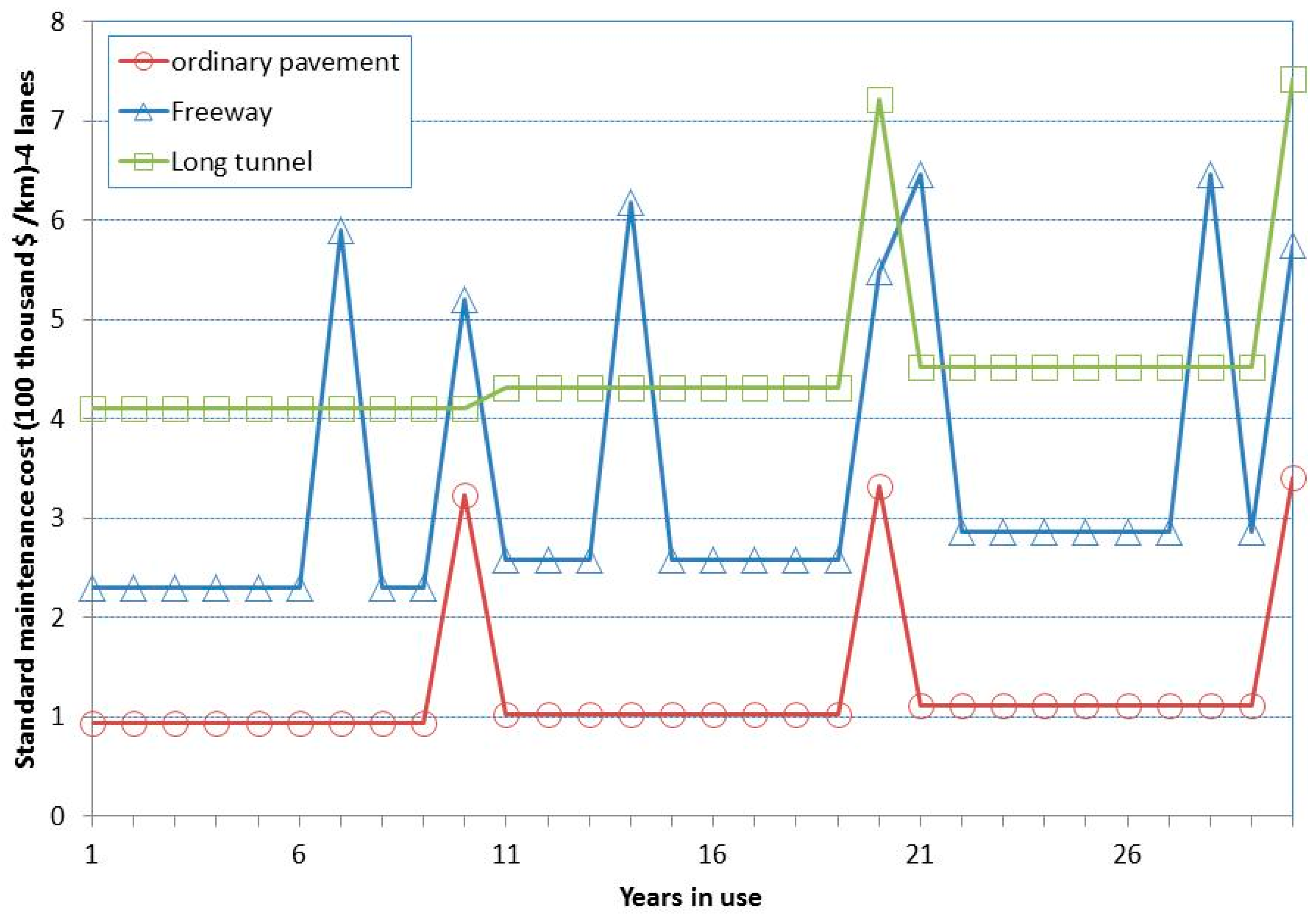
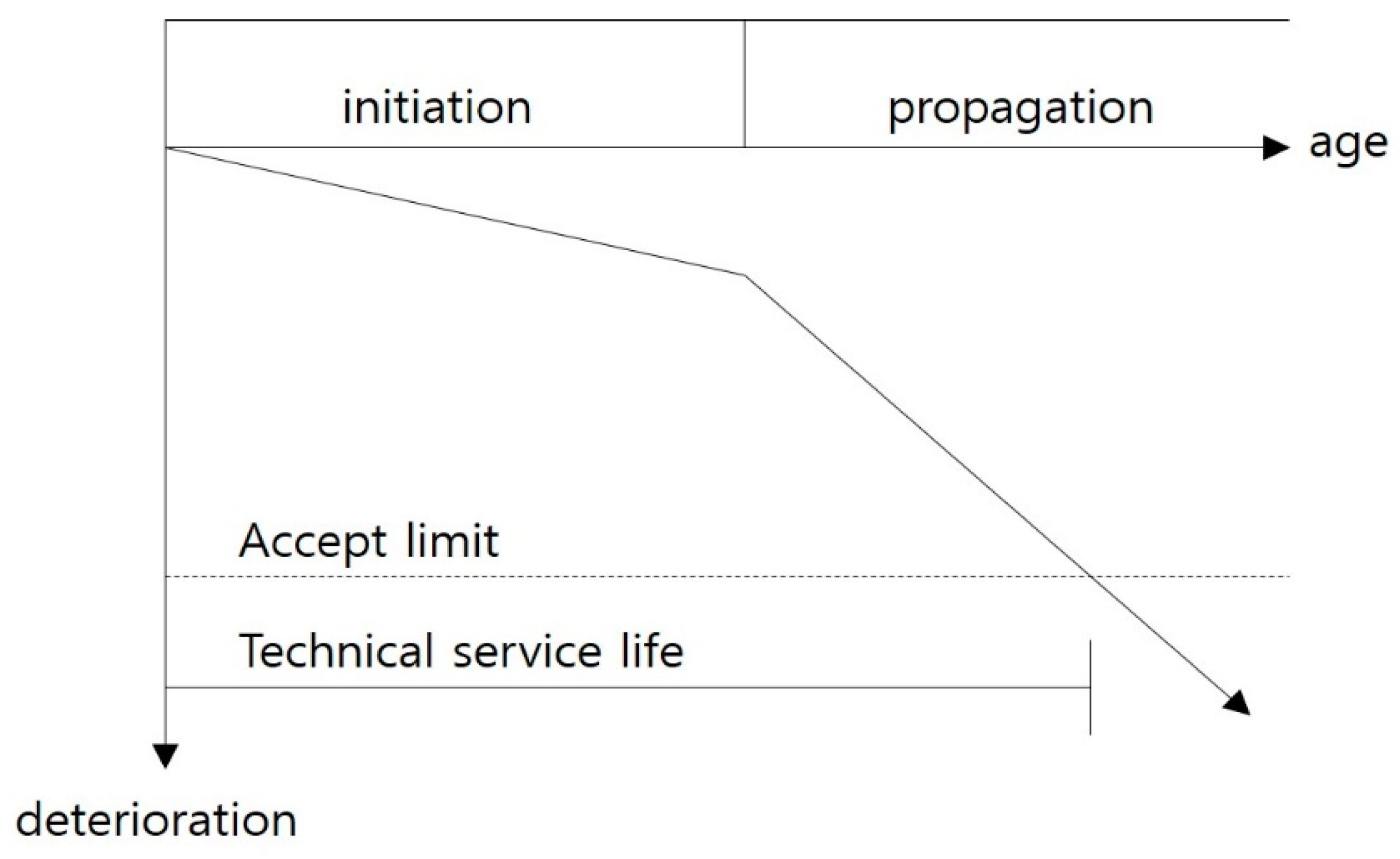
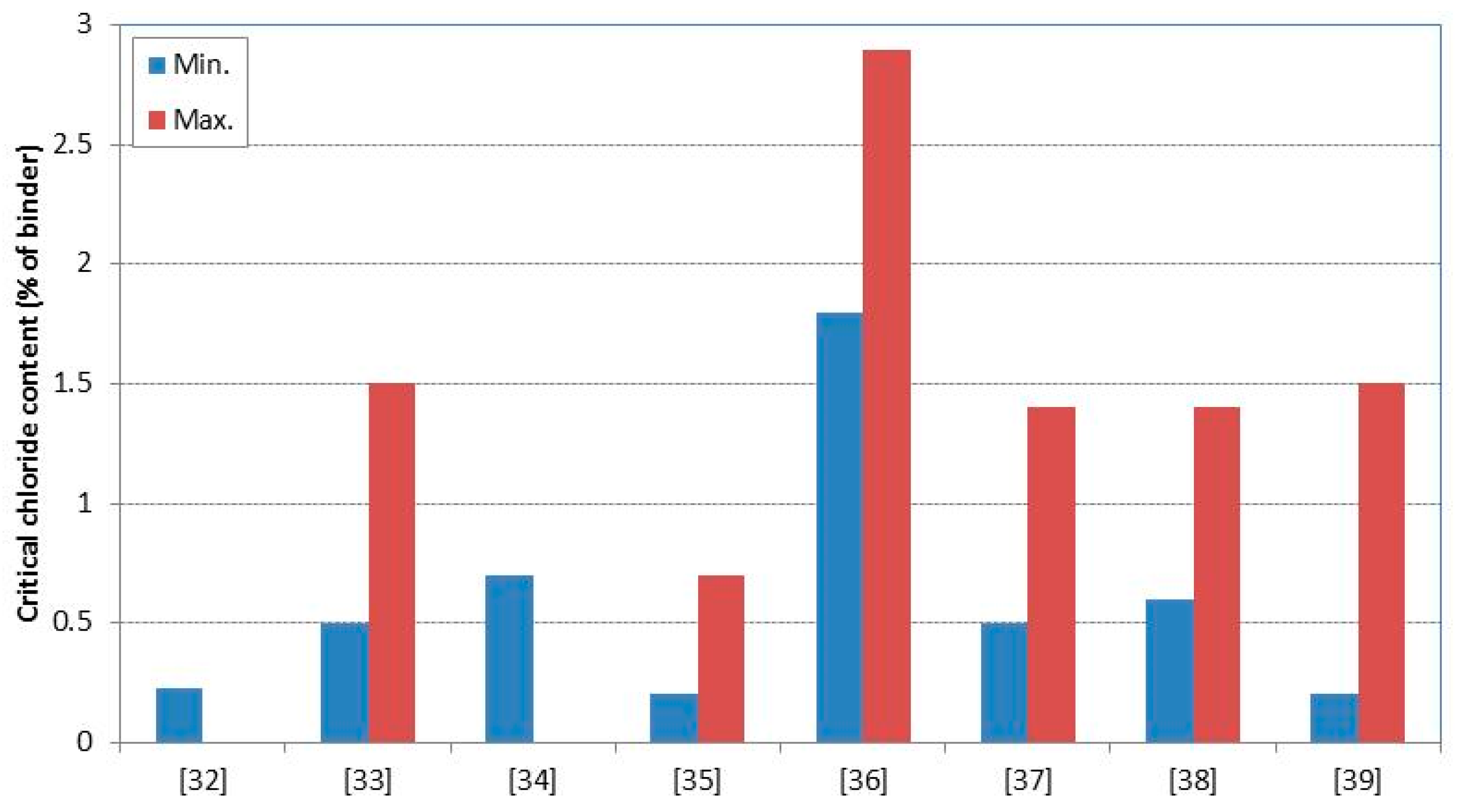
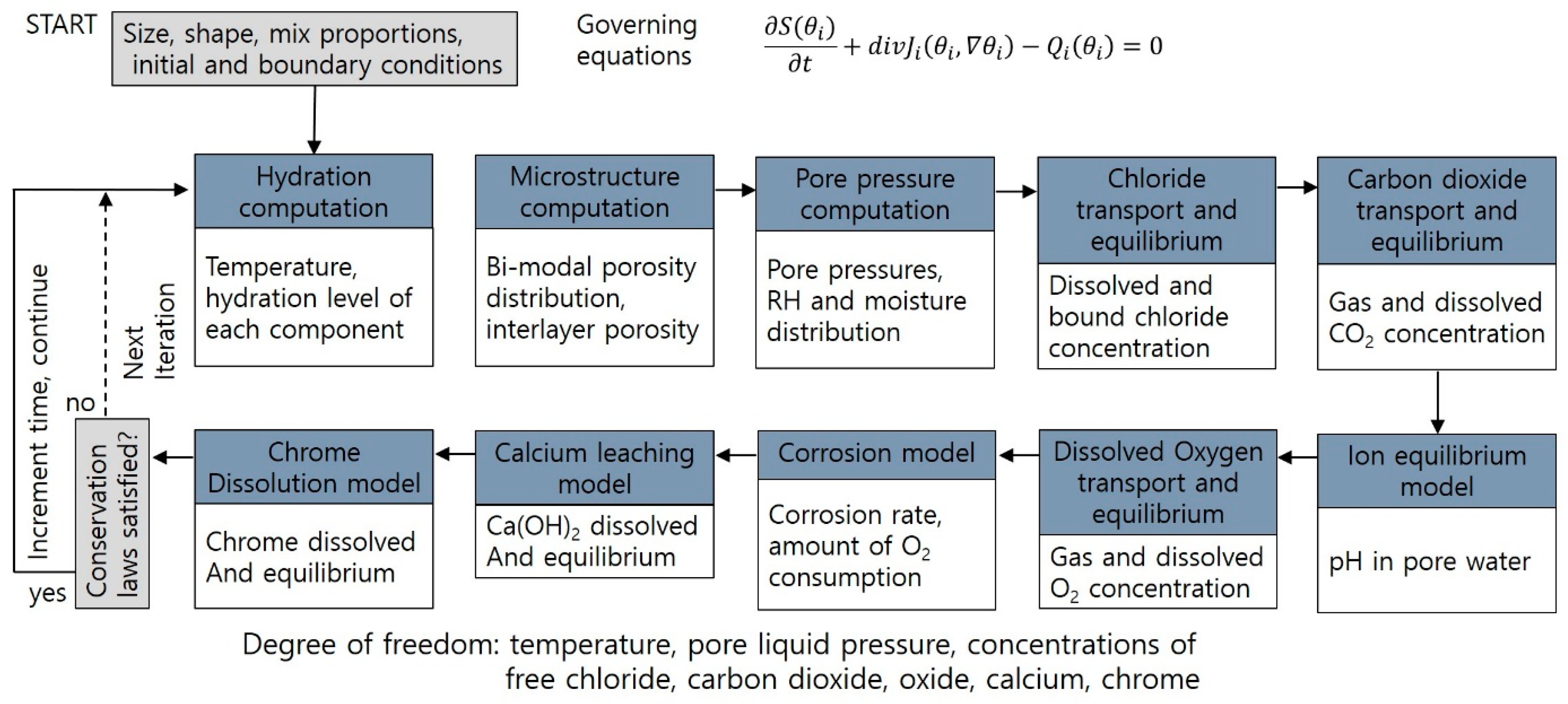
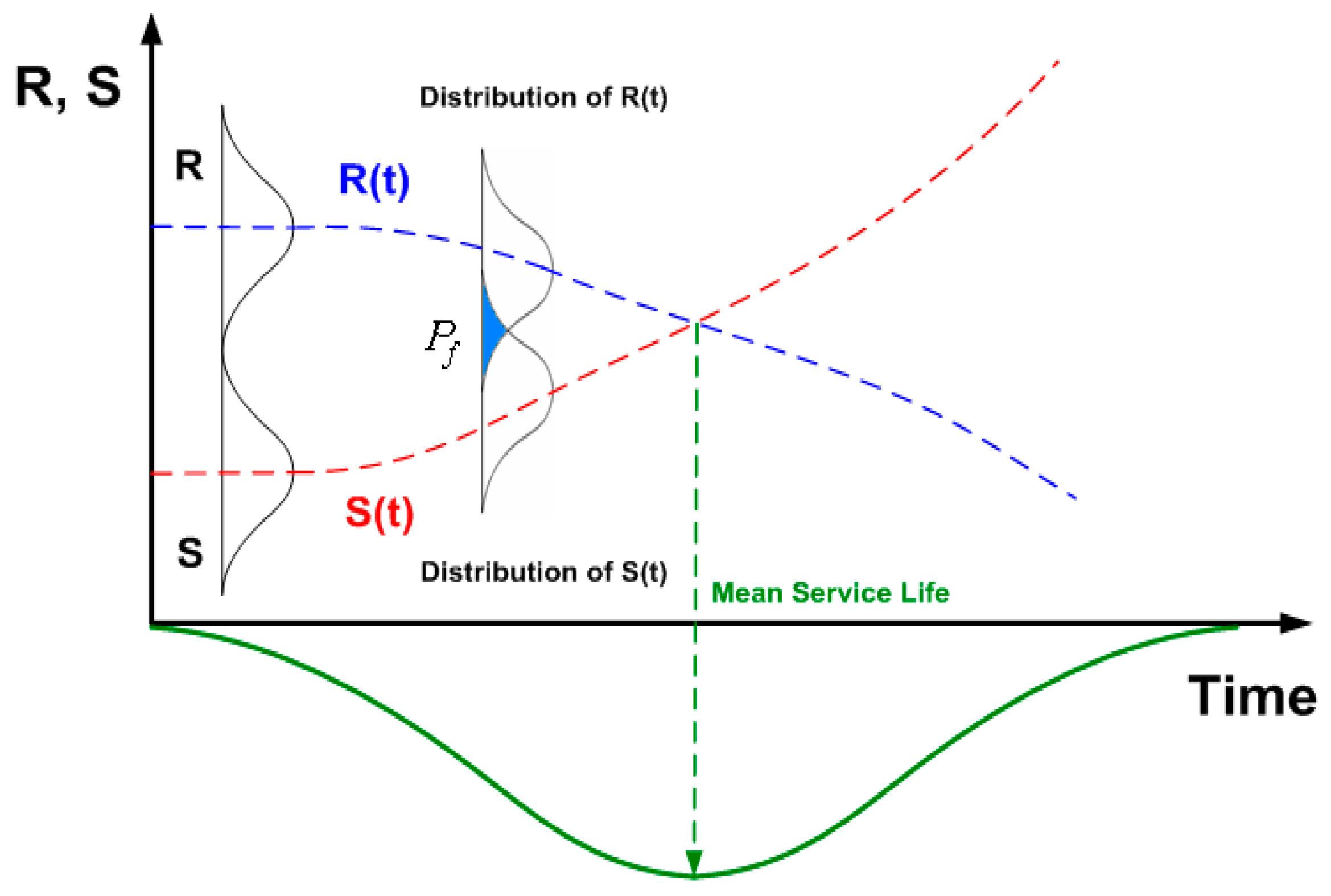

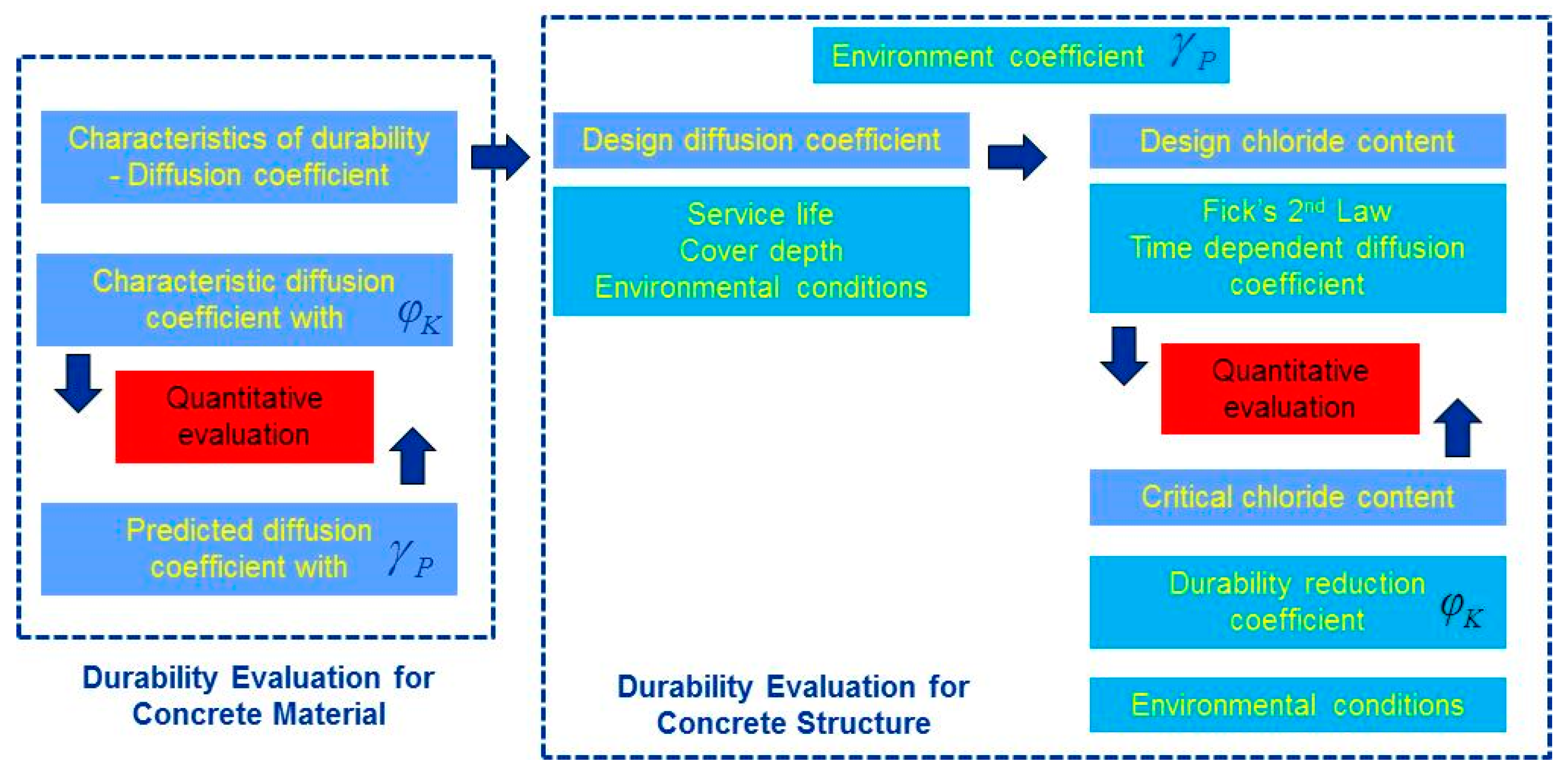
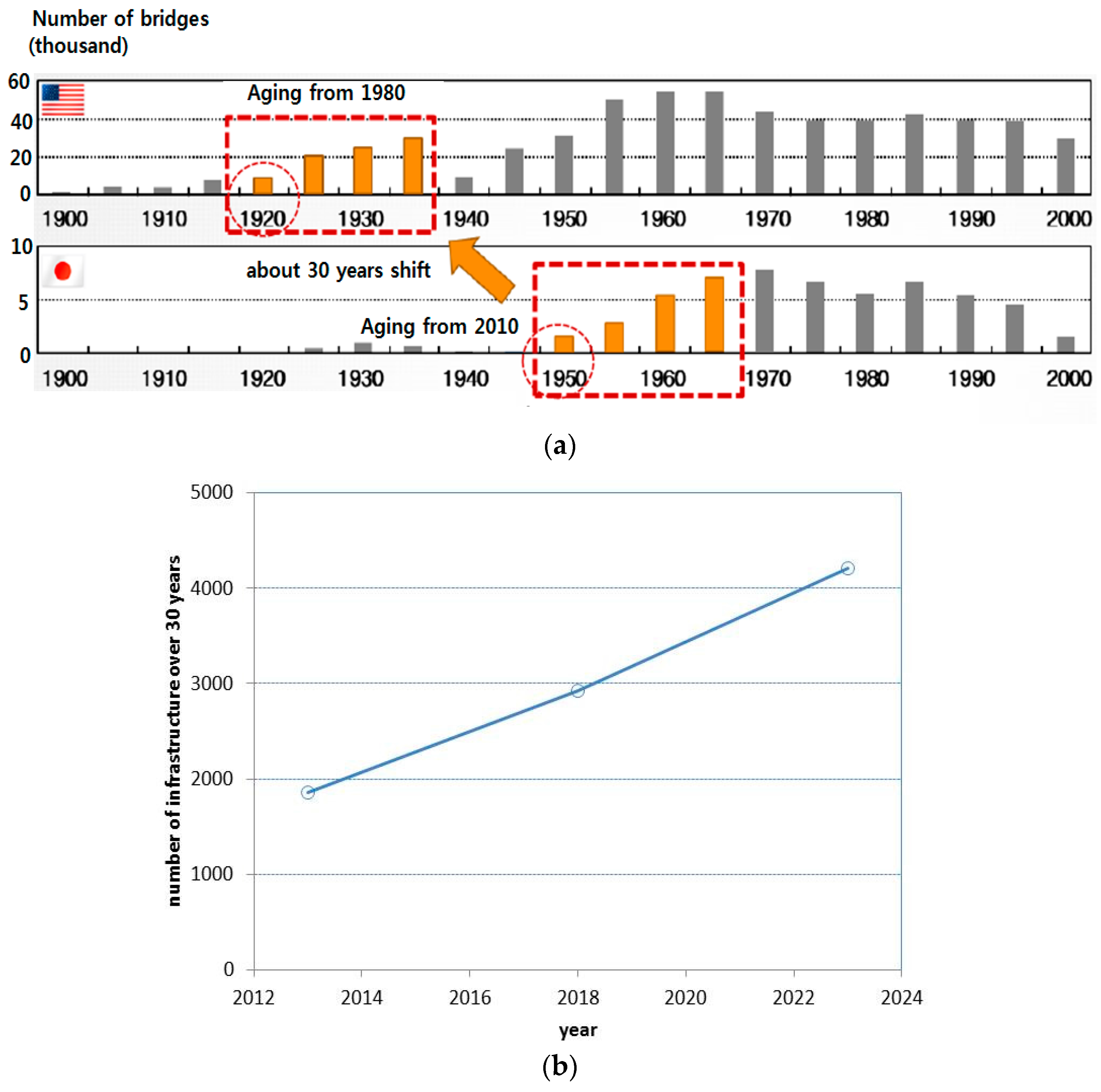
| Type | Source of Uncertainty |
|---|---|
| Physical | Inherent random nature of basic variables |
| Model | Governing mechanism and equation |
| Statistical | Assumption for probability density function—limited sample size |
| Decision | Definition of durability failure criteria |
| Deterministic |
|
| Probabilistic |
|
| Splash Zone | Distance from Coast (km) | ||||||
|---|---|---|---|---|---|---|---|
| Near Shoreline | 0.1 | 0.25 | 0.5 | 1.0 | |||
| Region with high airborne chloride concentration | Hokkaido, Tohoku, Hokuriku, Okinawa | 13.0 | 9.0 | 4.5 | 3.0 | 2.0 | 1.5 |
| Region with low airborne chloride concentration | Kanto, Tokai, Kinki, Chugoku, Shikoku, Kyushu | 4.5 | 2.5 | 2.0 | 1.5 | 1.0 | |
| Construction Conditions | |||
|---|---|---|---|
| Ordinary Construction | Concrete Products, or the Quality Equal to or Higher than Concrete Products | ||
| Environmental classifications | Offshore air | 45 | 50 |
| Splash zone | 45 | 45 | |
| Undersea | 50 | 50 | |
| Maximum Size Coarse Aggregate (mm) | |||
|---|---|---|---|
| 20 or 25 | 40 | ||
| Environmental Classifications | Offshore air, Splash zone | 330 | 300 |
| Undersea | 300 | 280 | |
| Life Time (Years) | Design Concrete Cover (mm) | |||||||||
|---|---|---|---|---|---|---|---|---|---|---|
| 25 | 30 | 35 | 40 | 50 | 60 | 70 | 100 | 150 | 200 | |
| 20 | 0.62 | 0.893 | 1.22 | 1.59 | 2.45 | 3.57 | 4.86 | 9.92 | 22.3 | 39.7 |
| 30 | 0.413 | 0.595 | 0.81 | 1.06 | 1.65 | 2.38 | 3.24 | 6.61 | 14.9 | 26.4 |
| 50 | 0.248 | 0.357 | 0.486 | 0.635 | 0.992 | 1.43 | 1.94 | 3.97 | 8.93 | 15.9 |
| 100 | 0.124 | 0.179 | 0.243 | 0.317 | 0.496 | 0.714 | 0.972 | 1.98 | 4.46 | 7.93 |
| Category | Severity | Class | Condition |
|---|---|---|---|
| C Corrosion protection of reinforcement | Not applicable | C0 | Concrete dry or protected from moisture |
| Moderate | C1 | Concrete exposed to moisture but not to external sources of chlorides | |
| Severe | C2 | Concrete exposed to moisture and an external source of chlorides from deicing chemicals, salt, brackish water, seawater, or spray from these sources |
| Exposure Class | Max. w/c | Min. f’C psi | Additional Minimum Requirements | |
|---|---|---|---|---|
| Maximum water-soluble chloride ion () content in concrete, percent by weight of cement (%) | ||||
| RC | PS | |||
| C0 | N/A | 2500 | 1.00 | 0.06 |
| C1 | N/A | 2500 | 0.30 | 0.06 |
| C2 | 0.40 | 5000 | 0.15 | 0.06 |
| Committee | Contents and Guidelines |
|---|---|
| ACI 201R [69] |
|
| ACI 210 [70] |
|
| ACI 362 [71] |
|
| ACI 357 [72] |
|
| Class Designation | Description of the Environment | Informative Examples Where Exposure Classes May Occur |
|---|---|---|
| No risk of corrosion or attack | ||
| X0 | For concrete without reinforcement or embedded metal: all exposures except where there is freeze/thaw, abrasion or chemical attack For concrete with reinforcement or embedded metal: very dry | Concrete inside buildings with very low air humidity |
| Corrosion induced by carbonation | ||
| XC1 | Dry or permanently wet | Concrete inside buildings with low air humidity Concrete permanently submerged in water |
| XC2 | Wet, rarely dry | Concrete surfaces subject to long-term water contact Many foundations |
| XC3 | Moderate humidity | Concrete inside buildings with moderate or high air humidity External concrete sheltered from rain |
| XC4 | Cyclic wet and dry | Concrete surfaces subject to water contact, not within exposure class XC2 |
| Corrosion induced by chlorides | ||
| XD1 | Moderate humidity | Concrete surfaces exposed to airborne chlorides |
| XD2 | Wet, rarely dry | Swimming pools Concrete components exposed to industrial waters containing chlorides |
| XD3 | Cyclic wet and dry | Parts of bridges exposed to spray containing chlorides Pavements Car park slabs |
| Corrosion induced by chlorides from sea water | ||
| XS1 | Exposed to airborne salt but not in direct contact with sea water | Structures near to or on the coast |
| XS2 | Permanently submerged | Parts of marine structures |
| XS3 | Tidal, splash and spray zones | Parts of marine structures |
| Structural Class | Exposure Class | ||||||
|---|---|---|---|---|---|---|---|
| X0 | XC1 | XC2/XC3 | XC4 | XD1/XS1 | XD2/XS2 | XD3/XS3 | |
| S1 | 10 | 10 | 10 | 15 | 20 | 25 | 30 |
| S2 | 10 | 10 | 15 | 20 | 25 | 30 | 35 |
| S3 | 10 | 10 | 20 | 25 | 30 | 35 | 40 |
| S4 | 10 | 15 | 25 | 30 | 35 | 40 | 45 |
| S5 | 15 | 20 | 30 | 35 | 40 | 45 | 50 |
| S6 | 20 | 25 | 35 | 40 | 45 | 50 | 55 |
| Exposure Classes | |||||||||||
|---|---|---|---|---|---|---|---|---|---|---|---|
| Types | No Risk of Corrosion or Attack | Carbonation-Induced Corrosion | Chloride-Induced Corrosion | ||||||||
| Sea Water | Chloride Other Than from Sea Water | ||||||||||
| X0 | XC1 | XC2 | XC3 | XC4 | XS1 | XS2 | XS3 | XD1 | XD2 | XD3 | |
| Maximum w/c | — | 0.65 | 0.60 | 0.55 | 0.50 | 0.50 | 0.45 | 0.45 | 0.55 | 0.55 | 0.45 |
| Minimum strength class | C12/15 | C20/25 | C25/30 | C30/37 | C30/37 | C30/37 | C35/45 | C30/37 | C30/37 | C30/37 | C35/45 |
| Minimum cement content (kg/m3) | — | 260 | 280 | 280 | 300 | 300 | 320 | 340 | 300 | 300 | 320 |
| Policy and Plans | Agenda (2013–2017) |
|---|---|
| 3rd Science-Technology Basic Plan | Safe City, New industry with ICT (Information and Communication Technology) convergence supported by Ministry of Science, ICT, and Future Planning |
| 5th Civil Technique Promotion Basic Plan | Step-to-Step ability for Enhancement of require performance supported by Ministry of Land, Infrastructure and Transport |
| 3rd SOC Safety and Maintenance Basic Plan | Active response safety maintenance and Needs for durability design supported by Ministry of Land, Infrastructure and Transport (Special law for city for maintenance) |
| Green Architecture Certification Plan | Eco building certification with performance grading and Durability introduction for structural design supported by Ministry of Land, Infrastructure and Transport, Ministry of Environment |
© 2017 by the author. Licensee MDPI, Basel, Switzerland. This article is an open access article distributed under the terms and conditions of the Creative Commons Attribution (CC BY) license ( http://creativecommons.org/licenses/by/4.0/).
Share and Cite
Kwon, S.-J. Current Trends of Durability Design and Government Support in South Korea: Chloride Attack. Sustainability 2017, 9, 417. https://doi.org/10.3390/su9030417
Kwon S-J. Current Trends of Durability Design and Government Support in South Korea: Chloride Attack. Sustainability. 2017; 9(3):417. https://doi.org/10.3390/su9030417
Chicago/Turabian StyleKwon, Seung-Jun. 2017. "Current Trends of Durability Design and Government Support in South Korea: Chloride Attack" Sustainability 9, no. 3: 417. https://doi.org/10.3390/su9030417





